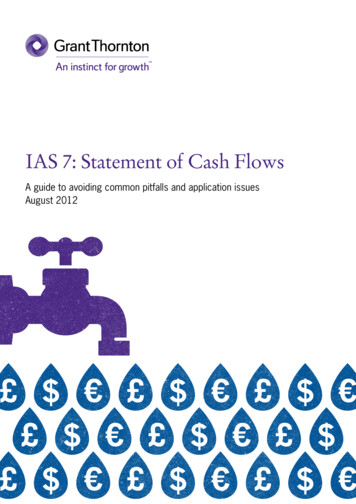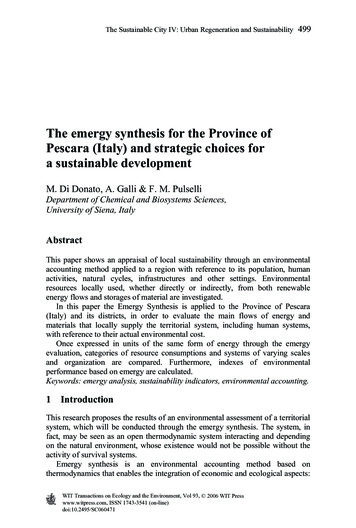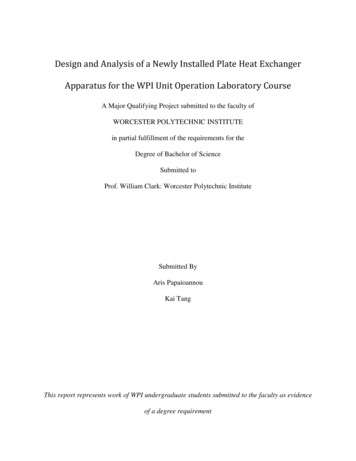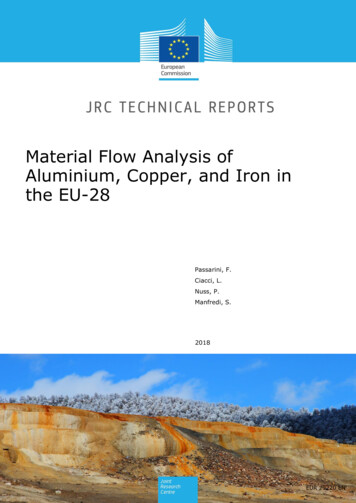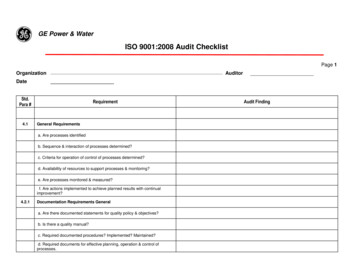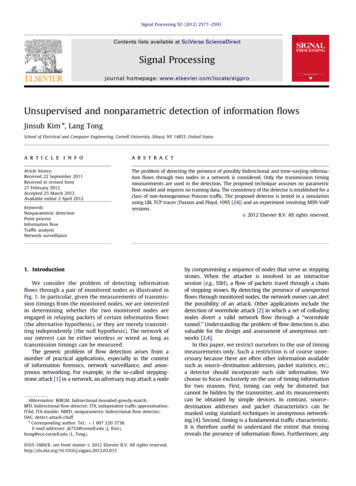
Transcription
ANALYSIS OF PROCESSES INFORMATION FLOWS ANDITEMS AS ADDITIONAL DESIGN FACTOR IN �——————————Rozehnal, P., Novák, �——————Petr Rozehnal / VSB - Technical University of Ostrava, Faculty of Economics, Department of AppliedInformatics, Sokolská tř. 33, Ostrava, 702 00, Czech Republic. Email: petr.rozehnal@vsb.czVítězslav Novák / VSB - Technical University of Ostrava, Faculty of Economics, Department of AppliedInformatics, Sokolská tř. 33, Ostrava, 702 00, Czech Republic. Email: vitezslav.novak@vsb.czAbstractCOBIT is a process-oriented IT governance framework. In the 2019 version, the frameworkoffers a significantly redesigned approach to prioritise processes and set process targetcapability levels. The design phase is very important to achieve a governance system infuture. Although there are several design factors defined in the design phase of COBIT2019, these factors do not assess process suitability and value for the governance system.Thus, connections and continuity among processes are not taken into considerationenough. Therefore, the aim of the article is to suggest another design factor based on theinterrelationships of processes in the COBIT framework represented by its informationflows. The nature of the proposed innovation is described, and the analysis of processinformation flows and items is performed. The article also publishes several inconsistenciesin COBIT 2019 documentation that have been identified in the process of research. Theapplication of process information flows and items analysis has been illustrated in two casestudies. We have identified new information that can be relevant to decision making in thedesign phase and discussed their importance for the planned governance system. Theresults could help to improve the quality of the design phase by providing additionalinformation about the context of the processes designed to ensure the governance system.Implications for Central European audience: The implications for senior managers in theCentral European region will be beneficial. Optimisation and effective use of informationtechnologies is a prerequisite for achieving long-term competitiveness. COBIT is a bestpractice framework, and its implementation in companies is largely based on the specificsof each organisation. Therefore, it is important to pay close attention to the implementationphase of the application of COBIT. Framework application positively supports the holisticapproach to management, resource optimisation, management based on responsibility andmeasurability. Today, these attributes of the organisation’s management are emphasisednot only in Central Europe but in developed countries in general.Keywords: IT; governance; COBIT; framework; analysis; processJEL Classification: M15, O33, O38Volume 10 Issue 4 2021https://doi.org/10.18267/j.cebr.264CENTRAL EUROPEAN BUSINESS REVIEW63
IntroductionThe transformation of enterprises towards the use of digital technologies as well as themassive use of data requires a comprehensive management approach based on theholistic principle. As Crowston (2003) states, interdependency and coordination areimportant topics in organisation studies. Information technologies (IT) are pervasive andcreate a dynamic environment full of possibilities and challenges. It is still more important toachieve IT/business alignment in organisations (Avison et al., 2004; Chan & Reich, 2007;Schlosser et al., 2012; Valorinta, 2011), which is a fundamental objective of informationtechnology governance/management. The value delivering is critically dependent on anability to create a management system where the processes are linked and support eachother. It is obvious that IT influence processes and vice versa (Luftman et al., 2013; Rahimiet al., 2016; Tarafdar & Gordon, 2007).IT governance, as a part of corporate governance, should ensure consistency amongaspects that are important for strategic business management. Terminologically, ITgovernance has undergone many changes, both in terms of management levels andcontent (ITGI, 2007; ISO, 2008; ISO, 2015; ISACA, 2012). Enterprise governance of IT(EGIT), see (De Haes et al., 2016; ISACA, 2018c) in this article is used.COBIT (ISACA, 2018c) is the worldwide known framework for EGIT. It should assist in theprocess of implementation and realisation of the EGIT system. COBIT is process-oriented.The key component is the objective. There are 40 objectives described in COBIT 2019 (37processes in COBIT 5). Each objective is referred to as one process. The process ischaracterised as follows: “a collection of practices influenced by the enterprise’s policiesand procedures that takes inputs from a number of sources (including other processes),manipulates the inputs and produces outputs (e.g. products, services).” (ISACA, 2012, p.92). The process is further described in the practices, which are specified in the activities.The process and other COBIT components (organisational structures; principles, policiesand frameworks; information; culture, ethics and behaviour; people, skills andcompetencies; services, infrastructures and applications) influence the governance systemand help to establish the transparent environment within the organisation.Big attention should be paid to the question of how to apply the framework to achieve betterresults in the planned EGIT system (Abu-Musa, 2009; Anindra et al., 2018). One of themost important issues of the new COBIT 2019 framework is a change in design andcustomisation (ISACA, 2018b). Due to EGIT complexity (Bartens et al., 2015), thechallenge for the design phase is how to customise COBIT for a given enterprise.In COBIT 5 version, processes for the EGIT system were selected by goals cascading withsupport of mapping tables that express relationships priorities. Such a procedure is rather aguideline for process prioritisation.In COBIT 2019, the phase of process priority rating has been significantly changed (ISACA,2018b). Eleven design factors, together with the recommended design process on how totailor the governance system, are described to improve process prioritisation. A differentfocus area should be taken into consideration, as well. All these aspects influence theselection of processes within the context of the current/specific situation in the organisationand the determination of process capability levels.64CENTRAL EUROPEAN BUSINESS REVIEWVolume 10 Issue 4 2021https://doi.org/10.18267/j.cebr.264
The design phase of EGIT system implementation supports prioritisation of managementobjectives (processes), components variation and establishes recommended capabilitylevel. Davenport and Short (1990) mentioned the exhaustive approach based on data foridentification of important processes or alternative one based on the general sense of whichprocesses are crucial. Our approach follows Davenport in both ways. There is no one idealway how to apply the COBIT framework and thus achieve the EGIT system. Processprioritisation and decision for EGIT system implementation are based on the combination ofexperts’ experiences, knowledge of company situation, knowledge of COBIT methodology.Thus, it is a mix of objective and subjective information, opinions and attitudes. During thedesign phase, COBIT uses partly mechanical calculation based on subjective/objectivevalues and opinions, and partly it is followed by a qualitative evaluation (although subjectiveagain because it is done by experts responsible for EGIT system implementation). Finally,there are selected processes sorted by relevance (their usefulness) to the assessed factors(i.e. current situation and organisation goals) and other components important for achievingthe EGIT system. Process capability level is also recommended.ISACA provides a software toolkit to support the design process. As stated above, part ofthe design phase is calculated, based on matrices, described in (ISACA, 2018b), in Chapter6, and customer inputs.Despite the publication of the COBIT framework, many factors recommended during thedesign phase suffer from a lack of documentation. Moreover, it is very difficult to measuretheir influence and potential impact on the EGIT system. In one sense, this may not besurprising because COBIT is practically oriented. However, the ability to implement theEGIT system is critically important, so all discussion and research that can help improve thequality of the design phase are valuable. The wrong composition of processes in the EGITsystem may cause a gap in the overall concept which should be holistic according toISACA. In the article, we suggest a new design factor that is based on the processcharacter of COBIT. Our approach considers process context by providing processinformation flows input/output analysis as another design factor to support processprioritisation.The design phase is an important area in the EGIT system life cycle. The higher the qualityof tailoring the governance system is, the higher the probability of obtaining a high-qualityEGIT system is. The impact of design factors is described in (ISACA, 2018b). AssumingEGIT system construction follows COBIT documentation, design factors play a crucial rolein the design phase. Our concept thus supports one of the key principles of the COBITframework - the holistic approach.The remainder of this article is organised as follows: the next chapter describes bothphases of the methodology concept. Chapter 2 provides a brief theoretical background.Chapters 3 and 4 describe case studies where our approach is applied. Chapter 5discusses general assessment, limitations and future research implications. Conclusion andlist of references finalise our article.1Methodology approachThe concept of the paper is based on process management theory and analysis ofprocesses relationships. In the context of the COBIT framework, we extend the designphase and customisation of governance solution published in (ISACA, 2018b).Volume 10 Issue 4 2021https://doi.org/10.18267/j.cebr.264CENTRAL EUROPEAN BUSINESS REVIEW65
The methodology is quantitative as well as qualitative. Quantitative analysis was performedusing a software tool developed by the authors. For the analysis, this tool used datarepresenting relationships between processes described in COBIT 2019 (ISACA, 2018a).The quantitative part of the analysis involves process information flows and items analysis(Note: COBIT 5 version used term process inputs/outputs). The source of information is theoriginal COBIT documentation (ISACA, 2018a). We analyse the relationships betweenprocesses to assess the role and importance of the given process in the context of selectedprocesses.The qualitative analysis follows the quantitative analysis. The reason to apply a qualitativeapproach is that COBIT cannot be mechanically implemented. It is necessary to tailor theEGIT system to fit organisation specifications. COBIT recommends concluding the designof the EGIT system with the final human evaluation to discuss the situation, resolveconflicts and achieve conclusions.Our analysis consists of three stages. First, the process entity is analysed. This stagedescribes the process view, which encapsulates issues from the next stages. Second, thepractices analysis stage, where practices of processes are analysed. Third, the informationflows stage, where inputs and outputs are considered (the approach is illustrated in Figure1).The position in governance system design workflow is between steps 3.7 and 4.1 (ISACA,2018b), Figure 4.1. It should support the final evaluation of the design phase. Onesupplement design factor is the input/output analysis of information flows. It can be used asfollows:1)Influenced management objective priority (in other words, processes) and targetcapability levels.2)Influenced component variation, specifically information flows and items (ISACA,2018b), Figure 3.1).2 Process information flows and items as an additionaldesign factorThe theoretical background of our approach is based on the business process managementconcept. Practical deployment of quantitative analysis is based on a software tool that isable to analyse relationships between processes.2.1 Business process managementBusiness process management (BPM) is an approach that covers concepts, methods andtechniques to support the design, administration and other activities related to businessprocesses (Weske, 2012). Jeston and Nelis (2014) state that BPM is a significantcontributor to achieving an organisation’s objectives. There is a reason to realiseprocesses, achieve value and meet objectives. This is done by process outcomes orproducts that are intended for customers (Davenport & Short, 1990). Rahimi et al. (2016)state that business process links business strategy to an organisation’s IT capabilities. Infact, BPM describes how process works and technology plays a crucial role by delivering aninfrastructure (Moller et al., 2007). The list of BPM definitions is presented and discussed in(Rosing et al., 2015).66CENTRAL EUROPEAN BUSINESS REVIEWVolume 10 Issue 4 2021https://doi.org/10.18267/j.cebr.264
Hammer (2002) understands the process as an organised group of activities that worktogether and create a result with value to the customer. Hammer underlines that activitiesmust work together and be aligned. The process is the way how to achieve the goal. Frogeret al. (2019) point out the BPM challenge in the area of alignment between human actorsand information systems. The process is the link among business strategy, people andtechnology. Thus, it supports innovation and agility (Kirchmer, 2015).The description of the process may be realised in different levels of detail (Řepa & Svatoš,2016). According to the level of detail, a process may contain subsections (activities,practices, steps). The process is in relationships with other processes and plays a rolewithin an organisation. COBIT process dependencies are shown in Figure 1. Thegovernance of processes means end-to-end managing of processes (Jeston & Nelis, 2014).BPM manages all relevant processes within the organisation because of a holisticapproach. In a process chain, processes are influenced by their predecessors(chronologically, they occur before and produce outputs) and affect successors(chronologically, they happen after and accept inputs).COBIT is a process-oriented framework. Each process is described in text form. Theframework does not contain a model of process flow. Although such a description is themost used (Figl & Recker, 2016), it has limitations for practical implementation. Eachprocess description contains input and output information flows from and to otherprocesses. Information flows and items represent process outcomes for the next processes(their customers). Examples of such outcomes, according to Davenport and Short (1990)marketing plan, contract as well as product or goods. While Crowston (2003) discussesdependencies theoretically in organisational structures, COBIT defines exact relationshipsbetween processes. Regarding the number of inputs and outputs (we identified nearly 500relationships, see below), it is difficult to express a complex process model for all COBITprocesses. However, it is possible to use the inputs/outputs analysis to get knowledgeabout the partial process context. In the article, we analyse predecessors and successorsup to the third generations (L1 means 1st level, L2 means 2nd level and L3 means 3rdlevel).COBIT application requires finding a suitable combination of processes and their level ofcapability to create an EGIT system. Our approach complements the implementationprocess with the element of process continuity, one of the fundamental principles in BPM.The decision-making process in the design phase, whose objective is a set of keyprocesses for building the EGIT system, is enhanced by the knowledge of the processcontext.Volume 10 Issue 4 2021https://doi.org/10.18267/j.cebr.264CENTRAL EUROPEAN BUSINESS REVIEW67
Figure 1 Process dependencies applied in COBITSource: authors2.2 Information flows and items as inputs/outputsThe basis of quantitative analysis is a software tool that uses and evaluates the mapping ofrelationships between processes presented in COBIT. For the purpose of the article, adatabase management system and a spreadsheet were used. The reason is simplicity,availability and mutual compatibility of both tools (the official ISACA toolkit is also based onthe spreadsheet).It is not necessary to research process dependency structures, as shown in (Crowston,2003). In COBIT, each process has assigned its direct input and output processes.However, these relationships are available only in PDF format. Relationships weretherefore transformed semi-manually into two tables representing two possible relationshipsbetween two processes: (1) process – predecessor, (2) process – successor. During thistransformation, 479 relationships were identified.For example, practice APO07.01 has its predecessor APO01.05, as APO01.05 producesinformation flow named Definition of supervisory practices, which is listed as input forAPO07.01.Therefore, it is logical to conclude that the process relationships tables processpredecessor and process-successor mentioned above are identical. Information stored inboth tables essentially describes the same relationships between processes. For thepurpose of inputs/outputs analysis, the table of process relationships was created (Figure2).Figure 2 Example of relationships between processes in the database management systemSource: authors68CENTRAL EUROPEAN BUSINESS REVIEWVolume 10 Issue 4 2021https://doi.org/10.18267/j.cebr.264
Note: Multiple inputs/outputs as used in (ISACA, 2018a, p. 23) are not included in thesetables. The influence of multiple inputs/outputs is assessed separately in the qualitativeanalysis phase.During the comparison of process-predecessor and process-successor tables, severalinconsistencies (details below) were identified. Since the authors of the article are notentitled to establish a correct version of relationships, these relationships showinginconsistencies were excluded from the analysis.The aim of the quantitative phase (supported by software solution) was to identify the mostfrequently occurring processes as predecessor or successors (up to 3rd level) for theselected set of processes (shown in Figure 1).For this purpose, the views were created that simulate the sequence of individualprocesses through several levels with the help of self-join operations on a single processsequences table. At the same time, the frequencies of processes for each level arecomputed for individual processes at given levels and the selected combination of inputprocesses. Subsequently, obtained frequencies were used for determining which processesare the most often used and, therefore, should be considered as important duringimplementation.The information flow between practices is also a part of the predecessor-successorrelationship. In the subsequent phases of the evaluation, it is thus possible to identify betterthe importance of relationships according to the transmitted information.It is necessary to identify the most influential factors to further analyse the results ofquantitative evaluation. Following factors were considered during the analysis: Inputs are more important than outputs. Inputs are important as predecessors torealise processes of the EGIT system. Outputs are important for successors; inother words, for the next development of the EGIT system outside the scope ofdefined goals.Three levels of predecessors and successors are used. The most important is theL1 level, next is L2, and finally L3.Evaluation of important processes, practices and information flows based on theirfrequencies of occurrence.The importance of selected processes is derived from the number of practicesused in EGIT system construction. For example, if the process contains fourpractices, and they are all used in the construction of the system, then the processis considered very important. Similarly, the low number of used practices leads theprocess to be considered unimportant for the construction of the system. Thesame stands true for information flows. Results of the presented analysis,therefore, identify the importance of the whole process or one of its practices orinformation flows. It should be noted that COBIT assigns each activity torecommended capability level and contains information about its information flows.Usually, the determination of capability levels is one of the outputs of the designphase. Therefore, our approach allows for a more detailed analysis and evaluationof the design phase.Volume 10 Issue 4 2021https://doi.org/10.18267/j.cebr.264CENTRAL EUROPEAN BUSINESS REVIEW69
2.3 Process inputs/outputs inconsistencies in COBIT 2019frameworkAfter the data transformation phase, both inputs and outputs were used, and relationshipswere compared. The following inconsistencies in inputs/outputs among process practiceswere found in (ISACA, 2018a) in the following information flows: Data classification guidelines, APO14.01 versus APO01.06 and APO01.07.Data integrity procedures, APO14.04 versus APO01.06 and APO01.07.Data security and control guidelines, APO14.08 versus APO01.07.Customer requirements for quality management, BAI11.05 and BAI11.06 versusAPO11.02.Root causes of problems, DSS03.05 versus DSS03.04.Plan of right-size I&T landscape including missing I&T capabilities, services andapplications, APO02.02 and APO02.03 versus APO01.10.Incident resolutions, DSS03.05 versus DSS02.05.Root causes of problems, DSS03.05 and DSS03.02. 3Case study 1This case study is described by ISACA (ISACA, 2018b), see p. 67. According to results inthis document, chapter 7.2.4., we have used processes that seem to be likely important forthe EGIT system for analysis (without correction after qualitative evaluation, see note at theend of the case study 1). There are only processes with the greatest priority rating (relativeimportance 75 and more on a scale from -100 to 100) in input/output analysis. DSS02 Managed service requests and incidents (75),APO13 Managed security (80),DSS04 Managed continuity (80),DSS03 Managed problems (75),BAI09 Managed assets (75),BAI10 Managed configuration (75).Case study 1 Quantitative part of the evaluationThe quantitative part of the evaluation is shown in Figures 3, 4, 5. Note: in the resultsbelow, processes selected within the initial design phase are included in the tables and arehighlighted with grey colour.Figure 3 shows the number of practices occurrences for process in total (see columnsnamed as Count) as inputs or outputs divided by levels in which they occur. Values onpredecessor side then represent the number of processes serving as inputs of analysedprocesses. Values on successor side then represent the number of processes serving asoutputs of analysed processes.E.g. on the L1 level, the most frequent input practices are practices of process APO12occurring eight times and APO09 occurring five times. On L2 level, the most frequent inputprocesses are APO14 occurring eight times, APO12 occurring 71 times. On L3 level, themost frequent input processes are APO12 occurring 20 times, then APO14 occurring tentimes etc. On the L1 level, the most frequent output processes are APO08 occurring fivetimes, then BAI06 occurring four times. On the L2 level, the most frequent processes are70CENTRAL EUROPEAN BUSINESS REVIEWVolume 10 Issue 4 2021https://doi.org/10.18267/j.cebr.264
APO08 occurring 12 times and MEA04 occurring 11 times. On the L3 level the mostfrequent processes are APO02 occurring 28 times, APO05 occurring 18 times and so on.Figure 3 The number of occurrences of processes on each level as predecessors andsuccessors (first 20 rows only)Source: authorsFigure 4 illustrates practice elements analysis where the structure of information is thesame as in Table 1 but with a focus on practices rather than processes. It can be seen thatthe most frequent input practice on the L1 level is APO12.06, occurring seven times, thenAPO09.03 occurring five times. On L2 level, the most frequent practice is APO12.06 andEDM03.03 occurring seven times, then APO11.02 occurring six times. L3 level: the mostfrequent input practice is EDM03.03, APO12.04 and APO12.02 occurring seven times, thenAPO12.06 occurring six times.Similarly, the most frequent output practice on the L1 level is BAI06.01, occurring fourtimes, then BAI03.11, MEA04.07, APO09.04 and APO08.03 all occurring three times. OnL2 level, the most frequent practices are APO12.01 occurring seven times, MEA01.03 andAPO02.02, both occurring six times. L3 level: the most frequent practice is APO02.02,occurring 14 times, and so on.Volume 10 Issue 4 2021https://doi.org/10.18267/j.cebr.264CENTRAL EUROPEAN BUSINESS REVIEW71
Figure 4 The number of occurrences of practices on each level as predecessors andsuccessors (first 20 rows only)Source: authorsInformation from Figures 4 and 5, therefore, give us an idea about the representation ofprocesses and, in deeper detail, their practices on both input and output sides of analysedprocesses.Finally, information flows elements are analysed. While the number of occurrences of allinformation flows for practice is shown in Figure 4, the numbers of occurrences of eachunique information flow are described in Figure 5. The goal of this analysis is to identify themost used information flows and consider their importance in the planned EGIT system. Onthe L1 level Risk-related root causes from APO12.06 is used five times as input, SLAs fromAPO09.03 three times and OLAs from APO09.03 is used twice etc. It should be noted thatthe APO 09 practice uses two different information flows that could not be distinguished inthe analyses mentioned above. Practice APO12.06 used three different information flows.72CENTRAL EUROPEAN BUSINESS REVIEWVolume 10 Issue 4 2021https://doi.org/10.18267/j.cebr.264
Figure 5 The number of occurrences of each information flow on each level as predecessorsand successors (first 20 rows only)Note: Predecessors, left part of the figure above, Successors, right part of the figure below.Source: authorsCase study 1 Qualitative part of evaluation and interpretation of findingsQualitative evaluation and resulting recommendations are based on quantitative analysis ofinformation flows. In (ISACA, 2018b), six processes were determined to be important incase study 1 for the EGIT system. Capability levels for 21 processes were alreadydetermined. In the final phase of the analysis, the roles of the three processes weresignificantly reevaluated. In qualitative evaluation, the most frequent processes (Figure 3),Volume 10 Issue 4 2021https://doi.org/10.18267/j.cebr.264CENTRAL EUROPEAN BUSINESS REVIEW73
practices (Figure 4) and information flows (Figure 5) on all observed levels were focusedon.Process APO12 Managed risk is used as a predecessor or successor on all observedlevels (L1-L3). The most frequent practice from this process is APO12.06 Respond to riskwhere its information flow Risk-related root causes are used as an input for otherprocesses. Based on the results obtained by input/output analysis and recommendationsfor process realisation, we evaluate the APO12 process as more important for the EGITsystem compared to the official evaluation (ISACA, 2018b). We recommend capability level4.Information flows of process APO09 Managed service level agreements are used as inputsfor EGIT system processes and their logical successors as well. Especially practiceAPO09.03 Define and prepare service agreements with information flows OLAs, SLAsserves as input for other EGIT system processes. Practice APO09.04 Monitor and reportservice levels frequently serve as an output for information flows related to servicemonitoring. Based on obtained results and taking into account connections betweenprocesses, APO09 is assigned to capability level 3.As mentioned above, our analysis does not cover processes with multiple outputs.However, these processes are also part of process flows and influence other processes.Especially process APO11 Managed quality consists of several practices that createinformation flows for successive processes. With regard to the mentioned above, werecommend increasing the target capability level for APO11 to 3.Roles of processes and practices from MEA should be considered as well, as theyinfluence all other processes. Practices MEA02.01, .03 and .04 are assigned to capabilitylevel 3 or greater. Therefore, process MEA02 should be assigned a greater capability levelas well. The realisation of practices from MEA2 requires detailed knowledge of the purposeof employing the EGIT system. The published case study does not allow evaluation ofpractice realisation. However, the approach presented in this article indicates theconnection between MEA02 and other planned processes. Similarly, MEA04 practicesserve as inputs for planned processes. In comparison to case study recommendations(ISACA, 2018b), capability levels are assigned suitably.Process BAI06 Managed IT changes evaluated mainly because of practices BAI06.01Evaluate, prioritise and authorise change requests and BAI06.03 Track and report changestatus. Information flows from practices BAI06.01 occur four times among its successors.Practice BAI06.03 was originally assigned to capability level 4 (ISACA, 2018b). ProcessBAI06 is assigned to capability level 3, which is in accordance with the case study results.Process APO02 Managed strategy was analysed as well. It frequents mostly amongsuccessors. Thus there are no recommendations about capability level for this process.74CENTRAL EUROPEAN BUSINESS REVIEWVolume 10 Issue 4 2021https://doi.org/10.18267/j.cebr.264
Table 1 Case study 1 Summary of Underesti
COBIT (ISACA, 2018c) is the worldwide known framework for EGIT. It should assist in the process of implementation and realisation of the EGIT system. COBIT is process-oriented. The key component is the objective. There are 40 objectives described in COBIT 2019 (37 processes in COBIT 5). Each objective is referred to as one process.
